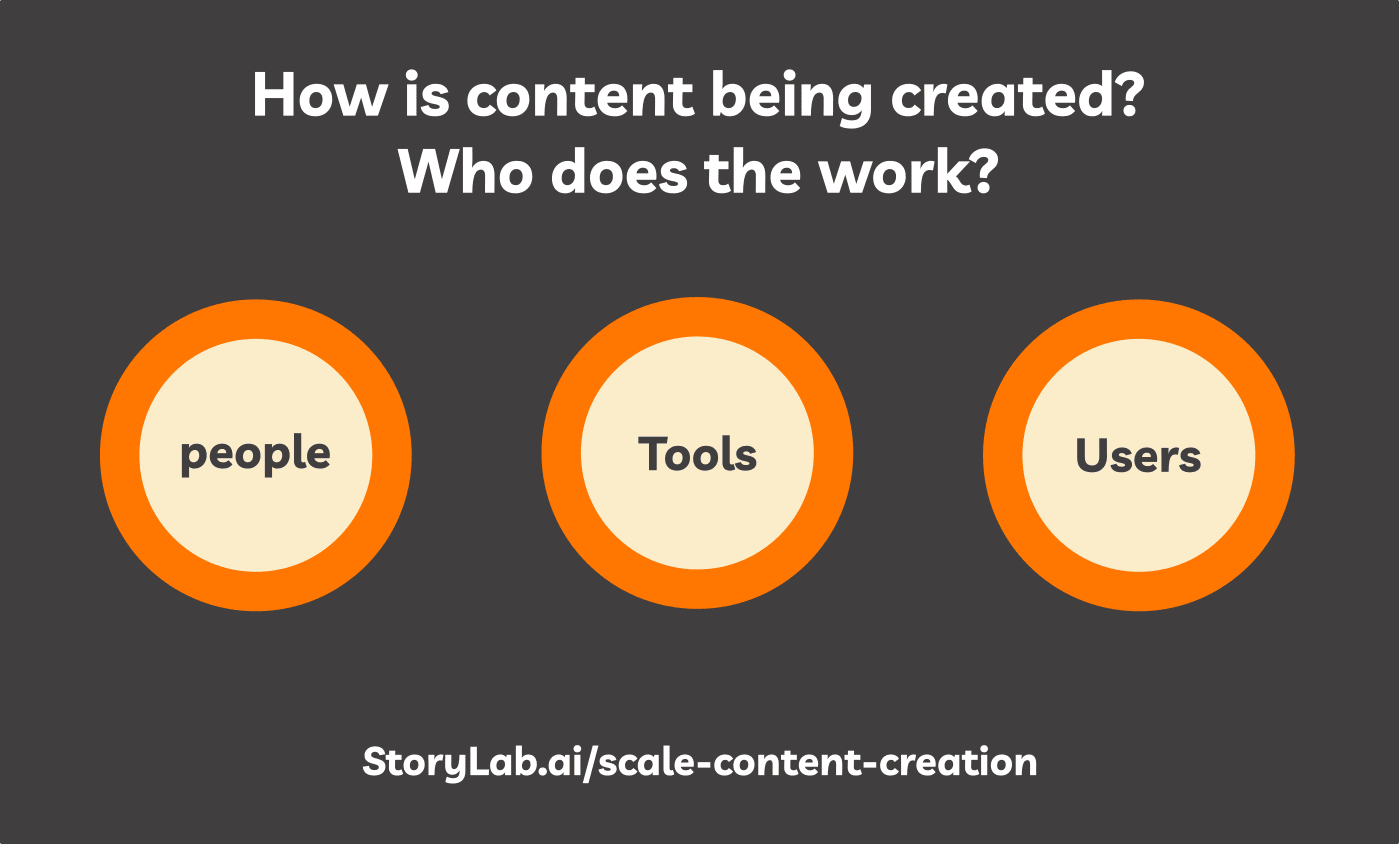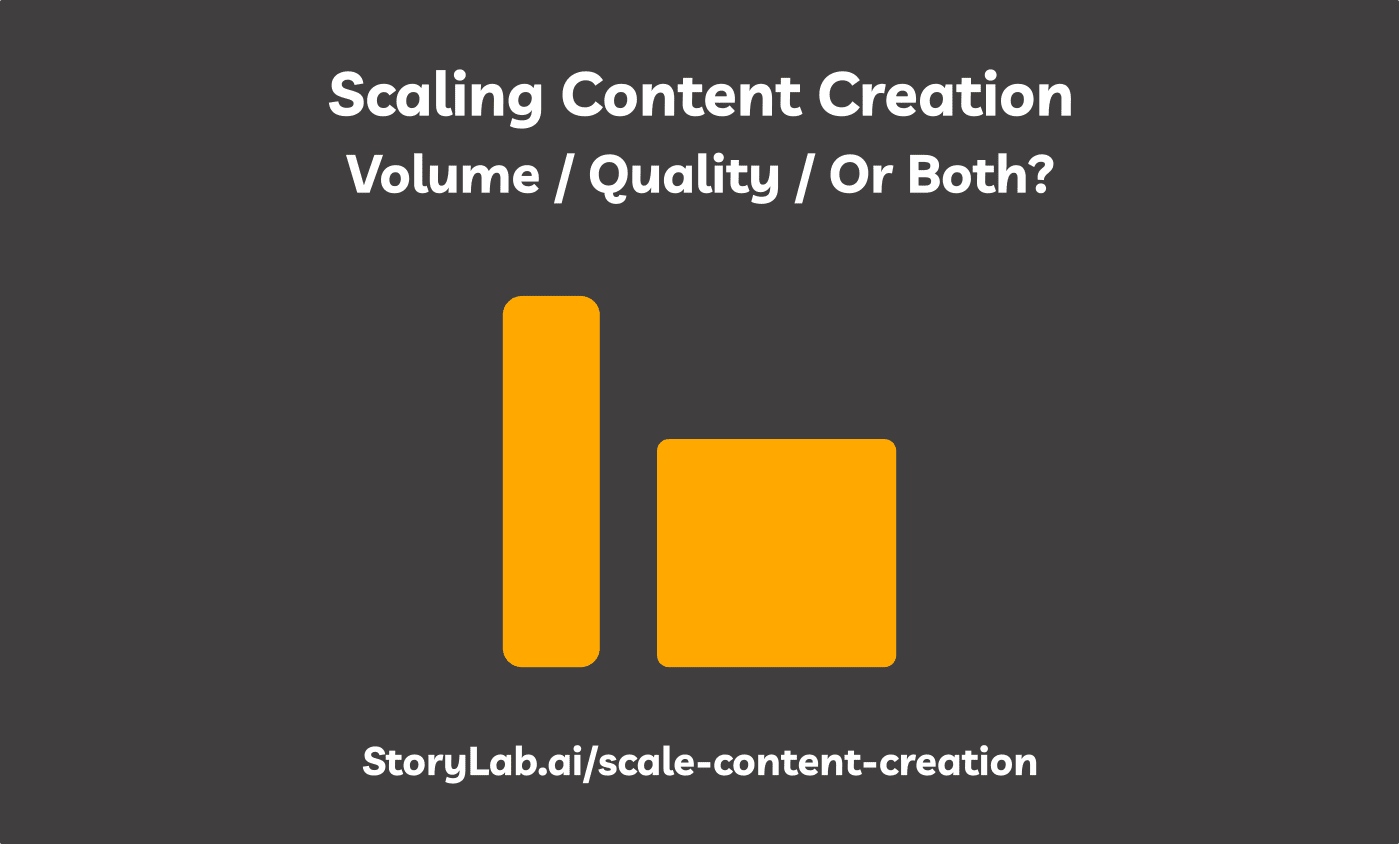How To Scale Content Creation in 2024
[People, Tools, Users]
It’s innate human to always want more.
The same goes for Scaling Content Creation.
No matter how many pieces of content we have, how well the processes are set up, we want more!
In this article, we’ll go through ways of scaling content creation and we’ll also have a look at a holistic content creation strategy and try to identify if we need more or better content (or both!).
Let’s get into it!
Scaling Content Creation – Who is Creating Content?
For the scaling content creation part, we want to have a look at 3 pillars:
- People
- Tools
- Users
And drill down to how each of the pillars can help to scale content creations and what the limitations are.
Spoiler alert, there is no perfect solution, but having a strategy to utilise all three pillars will win you the gold!

People are creating content in our organization
Most organizations are scaling their content creation with the help of people (employees and freelancers) and sometimes make use of Content Creation tools to write content and design visuals in a scalable way.
Everyone uses a typing and visual design program, but we’re going to talk about tools that actually help scale content creation. Let’s say Canva vs InDesign and StoryLab.ai vs Google Docs.
Pros for having people creating content
- Great content quality
- Great storytelling
Cons
- Difficult to really scale
- Relatively expensive
Tools have a big role for scaling content creation
As mentioned above, everyone is using tools for content creation, but not all tools help you scale your content creation at the same rate.
- We used to use Photoshop or InDesign for creating visuals, many have switched to Canva or at least InDesign templates to create visuals at scale.
- We used to organize our own photoshoots for all images we used, now people are more comfortable using Stock Photos and editing them.
- We used to pay people to check our writing. We now use Grammarly to find copywriting mistakes.
- We used to stare at a blank screen waiting for our writers block to make room for creativity. We now use Content Idea Generators, Social Media Caption Generators, Blog Outline Generators and more to help kickstart our project.
- We used to send drafts to colleagues and freelancers via email in a Microsoft Words Doc and hoping that we were both working in the latest version. We now use Slack and Google Docs to work together in real-time.
The big question is, how to you use tools to help with:
- Coming up with new ideas;
- Creating copy;
- Creating visuals;
- Collaborating withe colleagues and freelancers.
Pros for using the right content creation tools
- Help humans and users to create more and better content.
- Great value compared to the costs.
Cons
- You need to learn to use them the way they are supposed to be used.
Users are creating content in our organization (User Generated Content)
Quality User Generated Content is what have helped many platforms to get where they are today (Facebook (Meta), Etsy, Twitter, Quora, Medium, you name it.
So why do not all organizations go all in on User Generated Content?
Because it’s hard.
You need to set up tools, rules and frictions and sometimes algorithms to ensure content that is being created is valuable.
To get the most out of user generated content you need to:
- Give users the right tools to created content;
- Have enough frictions in place to filter out bad quality content, but not too much that noone want to get started;
- Optionally; have an algorithm in place to help people to find the right content;
- Have an incentive for people to create content;
- Have a sort of a community manager.
At the start, you don’t need to have all of the above points in place, but the larger it gets, the more you need to think about and implement these.
Pros for using User Generated Content
- Most scalable way to create content;
- Content based on insights of real users.
Cons
- When scaling, you need to set up tools, rules and frictions.
Let people, tools, and users work together and scale content creation
Every organization is different, so it’s going to be difficult to give one perfect solution. We hope that going through these three pillars helps you come up with your own content creation strategy and we’ll now jump into how we’re making use of these three pillars.
How StoryLab.ai is scaling content creation
People
Two of the co-founders are also content marketers. In the stage we are in right now where there is so much we need to learn from our audience, how our tools help people to create more and better content, we feel it’s necessary to write our own content.
Eventually, we’ll probably work with freelance content writers. But only when we know exactly how to guide them.
Tools
We use Canva and InkScape for creating great visuals. Fast. We use templates and have a Brand Style Guide so we don’t need to spend too much time thinking about the look and feel of the new visual.
We use our own Marketing Copy Generators to come up with new ideas, write our social captions, our email subject lines and help pretty much anytime we’re stuck and need a creativity boost.
We simply select the Copywriting Generator we need at that moment, describe what we want to write about and get copy ideas.
Users
For User Generated Content, we’re working on building an incentive for users to create content for us. In our case, we want to get content marketing experts to help educate our audience. In return we want to be able to get them in front of a large audience and SEO benefits.
We’re also working on building up a LinkedIn Group to get people to engage on the topics our users and us care about. It’s a work in progress, but we’re getting there.
Scaling Content Creation – Volume, Quality or Both

Raise your hand up if you said both! 🙂
Of course we want more AND better content, but I would like to go over a couple of things and try to make a case for when it makes sense to spend one hour on creating a new, let’s say blog post (let’s call those supporting content and minimal viable content) and when it makes sense to spend 5 hours, let’s call those ‘high investment content’.
High investment content (SkyScraper, 10x, Pillar Pages)
There are quite some terms for these ‘high investment pieces of content’ going around. Brian Dean calls it the SkyScraper Technique. The reason he calls it the SkyScraper techniques is because these pieces of content need to stand out above all the other pieces of content for that keyword like a SkyScraper.
Moz, or Rand Fishkin, calls it the ‘10x content‘. Content that is 10x better than all the other pieces of content for that keyword.
CMSs and SEO tools call it ‘pillar pages‘ or ‘cornerstone pages‘.
They basically all have the same intent;
Learn what’s already ranking on page one of Google and figure out how to create better content that will be worthy of that #1 spot.
Here’s a pillar page example that we’ve created: Inbound Marketing Strategy.
The pros of focusing on the SkyScraper / 10x content technique is that:
- You will improve the chances of claiming that #1 position;
- You will rank for a ton of long tail keywords;
- It’s easier to build links for one page instead of 5 individual pages;
- It’s easier to do content refreshes.
Cons:
- High resource investment with no guarantee that it will rank well
Minimal Viable Content (MVC)
One way to overcome the con of your SkyScraper, 10x, pillar page content is to create Minimal Viable Content (MVC).
You basically create a bunch of good enough pieces of content and check which one has the biggest potential to rank well.
When you have identified which pieces of content have a high potential, you morph them into pillar pages.
Minimal Viable Content does not mean write a 500 words article with no research. You don’t skimp on:
- Proper topic research
- Great keyword research
- Great writing
- Great On-page SEO
You should aim to create it with a lot less resources.
Be sure to make full use of our marketing copy generators.
Here’s a step-by-step guide on how we’ve written a great quality article in under 30 minutes with the help of our Blog Content Generators.
Supporting content
Supporting content is pieces of content that help you build topical relevancy in Google. These are often low resource investment articles that target a long tail, low competition keyword that is highly related to one of your pillar pages.
The goal is not to get a ton of traffic but to build topical authority and internal links to boost a given pillar page.
Don’t get me wrong. The goal is still to claim that #1 position in Google for that long tail keyword you’ve selected. That’s the best signal to Google that you’re an authority in this niche. It’s just that an individual article will not bring in a ton of traffic.
Let StoryLab.ai help you create more and better content
At StoryLab.ai we are committed to help you write more and better content and to help you reach your goals.
Check out or free Growth Storytelling Framework and bring your marketing efforts together in a holistic way.
You can access our framework for free here. We don’t need your email address or your money. Simply click, get access to it, make a copy, make it your own and rock!
Take your Content Marketing to the next level with our Storytelling Framework, Content Marketing Goals Template, Content Distribution Strategy, and more!
Be sure to try out our Marketing Copy Generators. You can simply start with a free trial. No credit card required and see how they can help you reach your goals. Here’s an overview of how you can improve your marketing with AI,
Happy writing!
FAQ
What does it mean to scale content creation?
Scaling content creation means increasing the volume and diversity of content produced by a business or individual, often by streamlining processes, leveraging technology, and potentially expanding the team, to meet growing audience demand and marketing objectives.
Why is scaling content creation important?
Scaling content creation is crucial for maintaining engagement with a growing audience, improving SEO performance, reaching wider demographics, and staying relevant in a competitive digital landscape. It supports marketing efforts across various channels.
How can you effectively scale content creation?
Effectively scale content creation by adopting a strategic approach: utilize content planning tools, create a content calendar, leverage content creation platforms, outsource when necessary, and repurpose existing content across different mediums and platforms.
What tools can assist in scaling content creation?
Tools like content management systems (CMS), project management software, content creation and design tools (e.g., Canva, Adobe Creative Suite, SoryLab.ai), and automation platforms can significantly streamline the content creation process and enhance productivity.
How do you maintain quality while scaling content creation?
Maintain quality by setting clear content standards, employing a consistent review and editing process, using templates for design consistency, and ensuring all content aligns with your brand voice and audience expectations.
Can outsourcing help scale content creation? How?
Outsourcing can help scale content creation by allowing you to tap into the expertise of freelance writers, designers, and videographers, thereby expanding your content production capacity without the overhead costs of full-time staff.
What role does content repurposing play in scaling content creation?
Content repurposing plays a crucial role by maximizing the value of existing content. It involves adapting and reusing content across different formats and platforms, effectively expanding your content library with minimal additional effort.
How can user-generated content (UGC) contribute to scaling content creation?
UGC contributes by providing a steady stream of authentic content created by your audience. Encouraging and curating UGC can fill your content calendar, enhance community engagement, and offer fresh perspectives to your audience.
What strategies can be employed to generate content ideas at scale?
Generate content ideas at scale by conducting audience research, monitoring social media trends, leveraging keyword research tools, hosting brainstorming sessions, and encouraging team members to contribute ideas based on their expertise and customer interactions.
How can analytics and feedback inform content scaling efforts?
Analytics and feedback provide insights into what types of content perform best, helping to refine content strategies, allocate resources more effectively, and tailor content to audience preferences, thereby optimizing the scaling process.
Jump back to a section
Author bio:
 Raul Tiru: Raul loves to build companies and help startups and scale-ups grow. Raul started his first website when he was 17 years old, has held several growth marketing positions in fast-growing companies, and has helped companies via his Freelance Marketing services. You can find Raul on his community GlobalOwls where he helps Nonprofits and Startups to do better marketing.
Raul Tiru: Raul loves to build companies and help startups and scale-ups grow. Raul started his first website when he was 17 years old, has held several growth marketing positions in fast-growing companies, and has helped companies via his Freelance Marketing services. You can find Raul on his community GlobalOwls where he helps Nonprofits and Startups to do better marketing.
Master the Art of Video Marketing
AI-Powered Tools to Ideate, Optimize, and Amplify!
- Spark Creativity: Unleash the most effective video ideas, scripts, and engaging hooks with our AI Generators.
- Optimize Instantly: Elevate your YouTube presence by optimizing video Titles, Descriptions, and Tags in seconds.
- Amplify Your Reach: Effortlessly craft social media, email, and ad copy to maximize your video’s impact.